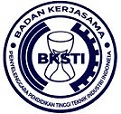Analisis Feasibilitas Penerapan Crowdshipping: Studi Kasus Kota Surabaya
Abstract
Full Text:
PDFReferences
Allahviranloo, M., Baghestani, A. (2019). A Dynamic Crowdshipping Model and Daily Travel Behaviour. Transportation Research Part E, 128, 175-190.
Boysen, N., Emde, S., Schewedfeger, S. (2022). Crowdshipping by Employees of Distribution Centers: Optimization Approaches for Matching Supply and Demand. European Journal of Operational Research, 296, 539-556.
Boysen, N., Fedtke, S. & Schwerdfeger, S. (2021). Last-mile delivery concepts: a survey from an operational research perspective. OR Spectrum 43, 1–58.
Braga, I. P. C., Dantas, H. F. B., Leal, M. R. D., Almeida, M. R., & Santos, E. M. (2019). Urban mobility performance indicators: a bibliometric analysis. Gestão & Produção, 26(3), e3828.
H, Chourabi et al., Understanding smart cities: An integrative framework. Proc. Annu. Hawaii Int. Conf. Syst. Sci., no. July 2014, pp. 2289–2297, 2012.
Han, L., Zhou, W., Li, W., Li, L. (2014). Impact of urbanization level on urban air quality: A case of fine particles (PM2.5) in Chinese cities. Environmental Pollution, 194, pp. 163-170.
Karakikes, I., Nathanail, E., Adamos, G., Karatsoli, M., Social media users as carriers into the last mile delivery. In Proceedings of the hEART 2018: 7th Symposium of the European Association for Research in Transportation, Athens, Greece, 5–7 September 2018.
Kauf S. (2016). City logistics - a strategic element of sustainable urban development. Transportation Research Procedia, 16, pp. 158-164.
Mckinnon, A. (2016). Crowdshipping: a Communal Approach to Reducing Urban Traffic Levels?. Research Gate.
Miranda, H. F., & Silva, A. N. R. (2012). Benchmarking sustainable urban mobility: the case of Curitiba, Brazil. Transport Policy, 21, 141-151.
OECD, OECD (2012), OECD Environmental Outlook to 2050, OECD Publishing. 2012.
Oliveira, A.H.S., Savelsbergh, M.W.P., Veelenturf, L.P., van Woensel, T. (2019). Chapter 15—Crowd-Based City Logistics. In Sustainable Transportation and Smart Logistics, Faulin, J., Grasman, S.E., Juan, A.A., Hirsch, P., Eds., Elsevier: Amsterdam, The Netherlands.
Paloheimo, H., Lettenmeier, M., Waris, H. (2015). Transport reduction by crowdsourced deliveries—A library case in Finland. Journal Clean Production, 132, 240–251.
Pourrahmi, E., Jaller, M. (2021). Crowdshipping in Last Mile Deliveries: Operational Challenges and Research Opportunity. Socio-Economic Planning Sciences, 78.
Punel, A., Ermagun, A., Stathopoulos, A. (2019). Push and Pull Factors in Adopting a Crowdsourced Delivery System. Transp. Res. Rec, 2673, 529–540.
Taniguchi E., Thompson R.G., Qureshi A.G. (2020). Modelling city logistics using recent innovative technologies. City Logistics, 46, pp. 3-12.
Wicaksono, S., Lin, X., Tavasszy, L.A. (2021). Market potential of bicycle crowdshipping: A two-sided acceptance analysis. Research in Transportation Business & Management.
Zehtabian, S., Larsen, C., & Wøhlk, S. (2022). Estimation of the arrival time of deliveries by occasional drivers in a crowd-shipping setting. European Journal of Operational Research.
DOI: http://dx.doi.org/10.24014/jti.v8i2.19743
Refbacks
- There are currently no refbacks.
Copyright (c) 2022 Christopher Setiawan, Amelia Santoso

This work is licensed under a Creative Commons Attribution-NonCommercial-ShareAlike 4.0 International License.
Jurnal Teknik Industri
P-ISSN 2460-898X | E-ISSN 2714-6235
Published by:
Industrial Engineering Department
Universitas Islam Negeri Sultan Syarif Kasim Riau, Indonesia
Office Address:
H.R. Soebrantas KM 15.5, Tampan, Pekanbaru, Riau, Indonesia 28293
email: jti.fst@uin-suska.ac.id
Indexed by:
JTI : Jurnal Teknik Industri under a Creative Commons Attribution-NonCommercial-ShareAlike 4.0 International License.

















